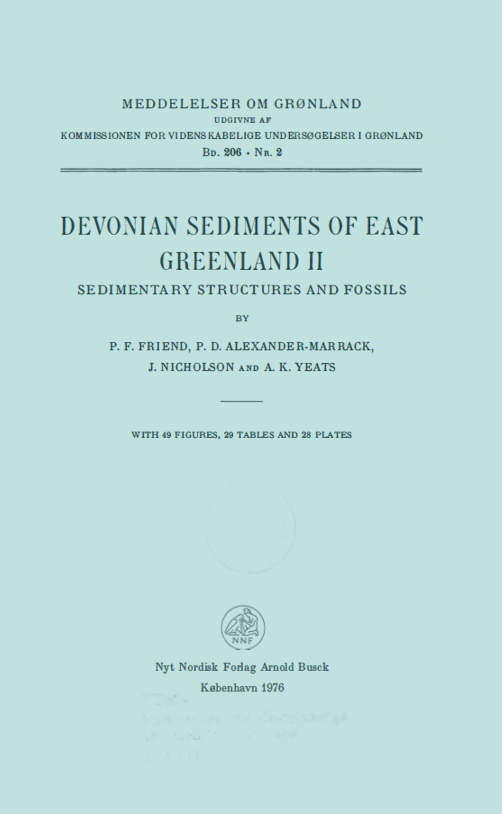Devonian Sediments of East Greenland II. Sedimentary Structures and Fossils.
DOI:
https://doi.org/10.7146/mog.v206.143410Abstract
Although this number contains morphological information about all the sedimentary structures and fossils seen in the Devonian sediments of East Greenland, a deliberate attempt has been made to provide information about their occurence in
relation to the other features of the sediment. Special use has been made of our method, described in Number one of this volume, of classifying 10 m lengths of sedimentological log.
Scour structures on stratification surfaces are almost ubiquitous in the different types of sediment sequence. Most scours are underlain by material that is finergrained than the material overlying them. However in some finer-grained sequences, fine-sediment fills scour structures. Tool marks are commonest in finer-grained sequences, as are various types of cracking. A 'dimple' structure is described.
Large-scale cross-stratification is described as 1) sandstone, planar foreset, 2) sandstone, curved foreset, 3) sandstone, low-angle, 4) siltstone. Planar foreset cross-stratification is only common in a few types of sequence and sandstone, low-angle and siltstone cross-stratification are more-or-less restricted to dominantly siltstone sequences. Many measurements of set thickness are presented. Symmetrical ripples are common in some siltstone sequences, and their morphology and size are described. Assymmetrical ripples (forming small-scale cross-stratification) and flatbedding in sandstone and in siltstone are described. Parting lineation is commonest in fine-grained sandstone sequences. A variety of sedimentary deformation structures is described, and the importance of pore-water pressure and grain-size is discussed. The important vertebrate faunas are reviewed briefly, and their occurrence in the sediment is described. Almost all finds have been of disarticulated bones, although there are a small number of articulated bone assemblages. However, observations on the occurrence of the various taxa allows one to make some suggestions about environments of life. Coarser-grained deposits usually include mixtures of genera and evidence of current scouring, though not abrasion. Finer-grained deposits sometimes show less taxonomically mixed assemblages, presumably reflecting
less transport of bones.
Plant fossils, up to 2 m in length, always appear to have been transported, in both sand and silt depositing environments. Burrows are abundant in some parts of the sequence, particularly in finer-grained (siltstone) sequences. Rootlets occur locally, usually in siltstone and finer-grained sandstone lithologies. One exposure shows two sets of large tracks, interpreted as the resting tracks of Bothriolepis.
In most sequences large cross-stratification is coarser-grained, or the same grade as flat sandstone bedding, which is coarser-grained or the same grade as asymmetrical ripples. The range of grain-sizes of these structures conform with those predicted from laboratory experiments. Flat bedded sandstones most commonly occur above large cross-stratification sets, and below small cross-stratification (if present), and this may reflect grain-size availability or changes of water depth. The thicknesses of sequences (cosets) of large cross-stratification vary considerably in the different types of sediment, and these may reflect differences in river channel depths. In contrast small cross-stratification and flat-bedding tended to accumulate to more-or-less similar thickness, perhaps in smaller depths. Grain-size cyclicity is not the dominant feature of the accumulation of the East Greenland Devonian that it is in some other Old Red Sandstone areas.

Downloads
Published
How to Cite
Issue
Section
License
Coypyright by the authors and the Commision for Scientific Research in Greenland. No parts of the publications may be reproduced in any form without the written permission by the copyright owners.

